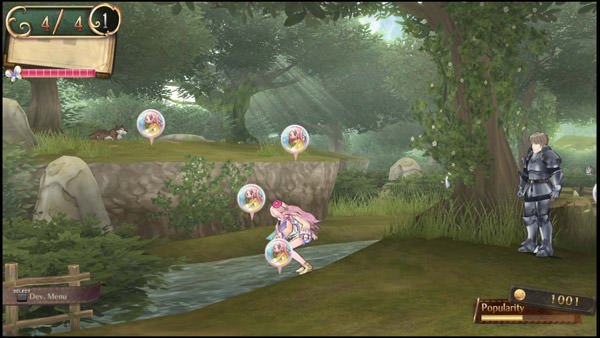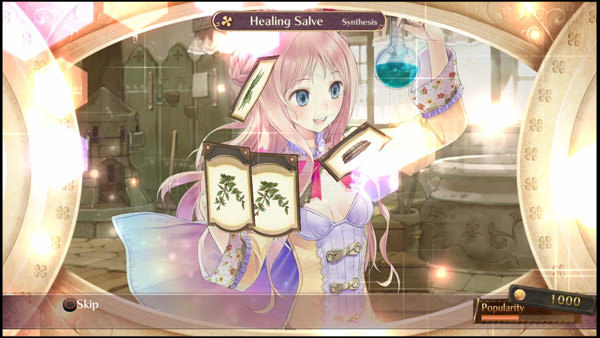Atelier Meruru: The Apprentice of Arland Review
 By Joan Mitchell | May 31, 2012
By Joan Mitchell | May 31, 2012
A quick look at the instruction manual raised doubts about playing this game. Having not played any of the previous Atelier titles, the cutesy graphics were enough of a draw until coming upon the manual’s battle section. Images of Final Fantasy with its ethereal characters in emo cutscenes and drawn out battle sequences quickly surfaced. Fans of the famous franchise are undoubtedly ready to take me to task about that observation, but since this is a review of Atelier Meruru, and not Final Fantasy let’s try to keep our focus.

The game begins with Meruru skipping classes and sneaking out to visit an alchemist’s cottage on the outskirts of town. In this fairly long opening we find out that Meruru is the Princess of Arls and is hell-bent on becoming an alchemist against her father’s wishes. Meruru eventually strikes a deal with her father to let her learn alchemy in exchange for developing the kingdom. She is given three years to complete this heroic task through Development Quests from Rufus, the kingdom’s butler. These development quests ultimately push the game’s story forward. Totori, a character from the previous Ateliergames, returns as Arls’ official Alchemist and agrees to let Meruru set up base in her cottage.
Progress in the beginning is a little slow, but once you’ve familiarized yourself with the controls, synthesizing items and how to complete tasks, the pace certainly picks up. The dreaded battle sequences came early, but were quick and certainly took a backseat to the goal of the game, which is collecting and synthesizing objects to accomplish your goal of being an alchemist and promoting kingdom development simultaneously. Helping players on their quest is the ability to take two other people with you, so picking and choosing partners becomes key. Then again, they only come into play (pun intended) in a fight since Meruru does everything else herself. While the battles are fairly repetitive, it doesn’t mean you’ll never meet challenging opponents along the way.
Synthesizing items is the main draw to the game. Of course before you can use alchemy you have to go out and gather your own ingredients. Gathering is an essential part of the game, and is generally is very straightforward since the “World Map” gives hints on where to gather different ingredients (you will find that while gathering fulfills much the recipe list, bartering can also be useful for more hard-to-find items). Just watch out for how many you gather and the quality of the ingredients; Meruru has a basket she uses to carry them but they can spoil if they’re in there too long and having high quality items counts a lot in certain concoctions or when you need to exchange them for coins.

Speaking of time and quality, a calendar at the top left of your screen keeps track of the days as they pass. This is another factor that keeps the game moving and encourages more strategy than free-play. With only three years to complete your kingly bet, being mindful of how much rest and time it takes to travel for your different quests becomes paramount. Even synthesizing products takes time, but it’s not so intrusive that it weighs down on enjoying the quests.
Quality determines how well you completed your tasks. Rufus reminds Meruru before her first quest that keeping constituents happy and content is the burden every royal should bear. The actions and decisions she makes could either boost her popularity or drag it down – very reminiscent of SimCity’s gameplay. Keep tabs of your popularity through the track bar at the bottom right of your screen or stop by the tavern to check out the bulletin board where you headline nearly every time. Not only does it tell you exactly how much your popularity goes up or down, it serves as a more comical dashboard of your accomplishments, levels and faux pas in a very tongue-in-cheek tone. While in the tavern, pick up some tasks from Filly that you can complete and report back and earn money. Here, quality dictates how much you will get paid. As previously mentioned, quality also influences the items you create. You get what you give – poor condition ingredients yield lesser quality goods. Upon creating items through your budding alchemy skills, you have the option of assigning qualities to them that only go so far as the extent of the raw materials used.

That can be said for the game in general too. It truly lets you reap what you sow and if you really put some effort into it, the game delivers a rewarding experience. This is not a game where it takes a while to build up or starts out too challenging and kills your enthusiasm. Instead, it hits the right balance in playability and difficulty that months go by in the game unawares and you catch yourself secretly wishing Meruru was a more adept negotiator and pushed her father for five years instead of three (she is training to be alchemist after all, not the Arls’ Treasurer). The graphics are very exquisite and appealing in true anime and manga fashion, but should not be discounted as being geared only for female gamers. The dialogue pushes the envelope and borders on being saccharine, but there should be enough of a challenge in the game to make this worthwhile for guys as well. The game is rated T for Teen, but some dialogue could be construed as having subtle innuendos for more mature-thinking gamers who think it is in jest. This might give some parents pause, but the instances for such dialogue are very subtle and few and far between.I actually found leveling up a little more problematic since some products crucial to accomplishing a quest require you to create them but you must be at a certain level to do so. It can cost you precious time trying to level up and not to mention raw materials if you try to synthesize before reaching a level and end up having it be a bust. Keeping track of what you’ve gathered becomes more important as you obtain more items and create new ones. Currently, the list provides an ability to sort alphabetically, but it seems that it doesn’t follow the English alphabetical arrangement. A minor setback, but not a deal-breaker as it is something that can be patched.
Simply Put
Having not played the other Atelier games did not hinder me from enjoying this game. While having that background could have possibly enhanced my experience with it; this game could very well stand on its own. Any reservations I had about playing this were certainly dispelled and it just goes to show you can’t judge a book by its cover. Or, in this case, you can’t judge a game by its manual.
Note: Atelier Meruru: The Apprentice of Arland was reviewed on PlayStation 3. A physical copy of the game was provided by the publisher/developer.




